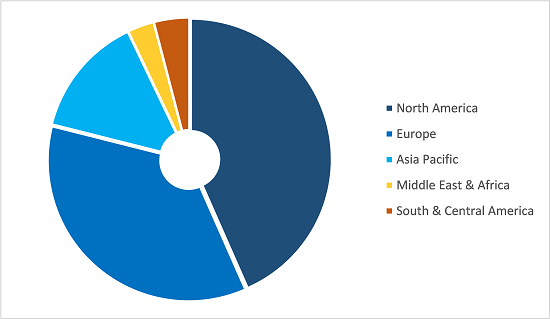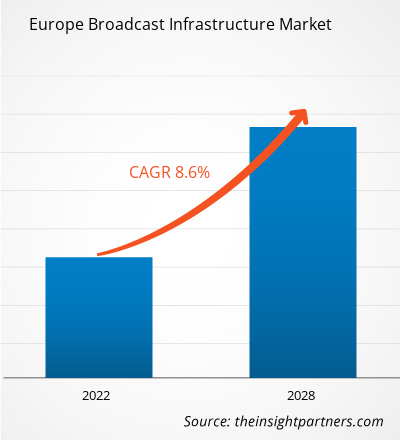The Europe broadcast infrastructure market is expected to grow from US$ 1,284.6 million in 2021 to US$ 2,295.7 million by 2028; it is estimated to register a CAGR of 8.6% from 2021 to 2028.
Digital Terrestrial TV (DTTV) is an implementation of digital television technology to provide a greater number of channels with better picture and sound quality using aerial broadcasts. The enthusiasm toward video-on-demand (VOD) services among the population is growing exponentially in today’s fast-paced and technologically advanced world. With the availability of unlimited choices such as Amazon Prime, Netflix, YouTube, Hotstar, Disney+, and on-demand channels of broadcasters, viewers are served with a vast range of options than ever before. Despite the dominance of these networks, terrestrial television continues to assert its position as a basic service to viewers worldwide. Furthermore, the VOD industry contains several business models, service deals, and access modes, which continue to grow significantly. Viewers rely on the VOD services that are delivered at affordable rates and help in delivering a diverse viewing experience.Nearly 95% of European households have TVs and the penetration of DTT is expected to grow. The French TV broadcasters, including TF1, France Televisions, M6, and Canal+, have invested ~€125 million annually in terrestrial network TDF. Furthermore, by the end of 2020, the share of households depending on digital terrestrial TV for their main TV set reached more than 55% in Spain, 33% in the UK, 57% in Italy, and 22.5% in France. Therefore, with the increasing adoption of TV sets and expenditure on terrestrial networks for video quality, and entertainment, the demand for DTT has also boosted.
The outbreak of the COVID-19 pandemic is expected to have a bigger impact on economies such as UK, Italy and Germany the imbalance in the demand and supply side, and the lockdown phase in several European countries have significantly impacted the broadcast infrastructure market in the first half of 2020. The growth of the broadcast infrastructure market is hampered due to the temporary shutdown of production plants and the scarcity of laborers which highly impacted the broadcasting hardware production. Moreover, the lockdown phase has drastically affected the supply chain, which has further affected the ability of companies to deploy advanced components to enhance their infrastructure competencies. Furthermore, the TV networks are strengthening themselves for a drastic drop in ad sales revenue as brands have slashed marketing budgets and pulled campaigns amid the COVID-19 pandemic. The pandemic has had a massive impact on the broadcast industry, shaping regulatory guidance, and disrupting new trends, as well as strict compliance with COVID-19 protocols in the UK, Spain, Germany, Italy, and France. However, with the normalization of economies across Europe, the production of broadcasting hardware gained its momentum. Also, with the extended remote working culture across the region, the adoption of various broadcasting channel is expected to rise thereby having a significant growth opportunity for growth of the market in the forecast period. Thus, the overall impact of COVID-19 on the European region is low to moderate.
Europe Broadcast infrastructure market Revenue and Forecast to 2028 (US$ Million)
- This FREE sample will include data analysis, ranging from market trends to estimates and forecasts.
Europe Broadcast infrastructure market Segmentation
Europe Broadcast infrastructure market – By Component
- Hardware
- Software
- Services
Europe Broadcast infrastructure market – By Application
- OTT
- Terrestrial
- Satellite Spectroscopes
- IPTV
- Others
Europe Broadcast infrastructure market – By Technology
- Digital Broadcasting
- Analog Broadcasting
Europe Broadcast infrastructure market – By Country
- Germany
- France
- Italy
- UK
- Russia
- Rest of Europe
Europe Broadcast infrastructure market – Company Profiles
- Cisco Systems, Inc.
- Clyde Broadcast Technology
- CS Computer Systems Ltd.
- Dacast Inc.
- EVS Broadcast Equipment SA
- Grass Valley
- Kaltura
- Nevion
- Ross Video Ltd
- BROADCASTING CENTER EUROPE S.A.
Europe Broadcast Infrastructure Report Scope
| Report Attribute | Details |
|---|---|
| Market size in 2021 | US$ 1,284.6 Million |
| Market Size by 2028 | US$ 2,295.7 Million |
| Global CAGR (2021 - 2028) | 8.6% |
| Historical Data | 2019-2020 |
| Forecast period | 2022-2028 |
| Segments Covered |
By Component
|
| Regions and Countries Covered | Europe
|
| Market leaders and key company profiles |
- Historical Analysis (2 Years), Base Year, Forecast (7 Years) with CAGR
- PEST and SWOT Analysis
- Market Size Value / Volume - Global, Regional, Country
- Industry and Competitive Landscape
- Excel Dataset



Report Coverage
Revenue forecast, Company Analysis, Industry landscape, Growth factors, and Trends

Segment Covered
Component, Technology, and Application

Regional Scope
North America, Europe, Asia Pacific, Middle East & Africa, South & Central America

Country Scope
UK, Germany, France, Italy, Russia
Trends and growth analysis reports related to Technology, Media and Telecommunications : READ MORE..
The List of Companies - Europe Broadcast Infrastructure Market
- Cisco Systems, Inc
- Clyde Broadcast Technology
- CS Computer Systems Ltd.
- Dacast Inc.
- EVS Broadcast Equipment SA
- Grass Valley
- Kaltura
- Nevion
- Ross Video Ltd
- BCE – BROADCASTING CENTER EUROPE S.A.

 Get Free Sample For
Get Free Sample For